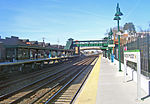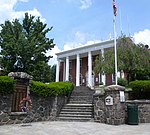Spann House
Buildings and structures in Yonkers, New YorkHouses completed in 1897Houses in Westchester County, New YorkVictorian architecture in New York (state)
Spann House is an historic Victorian-style building in Yonkers, New York. Spann House was constructed in 1897 as a single-family residence. The house was built in regional stone at a time when all the neighboring houses were built in wood. Spann House is one of the few buildings in Yonkers with entirely stone bearing walls. Spann House was converted to a multifamily residence in 1931. In 1999, it was purchased and renovated.
Excerpt from the Wikipedia article Spann House (License: CC BY-SA 3.0, Authors).Spann House
Warburton Avenue, City of Yonkers
Geographical coordinates (GPS) Address Nearby Places Show on map
Geographical coordinates (GPS)
| Latitude | Longitude |
|---|---|
| N 40.97575 ° | E -73.88673 ° |
Address
Warburton Avenue 1180
10701 City of Yonkers
New York, United States
Open on Google Maps








